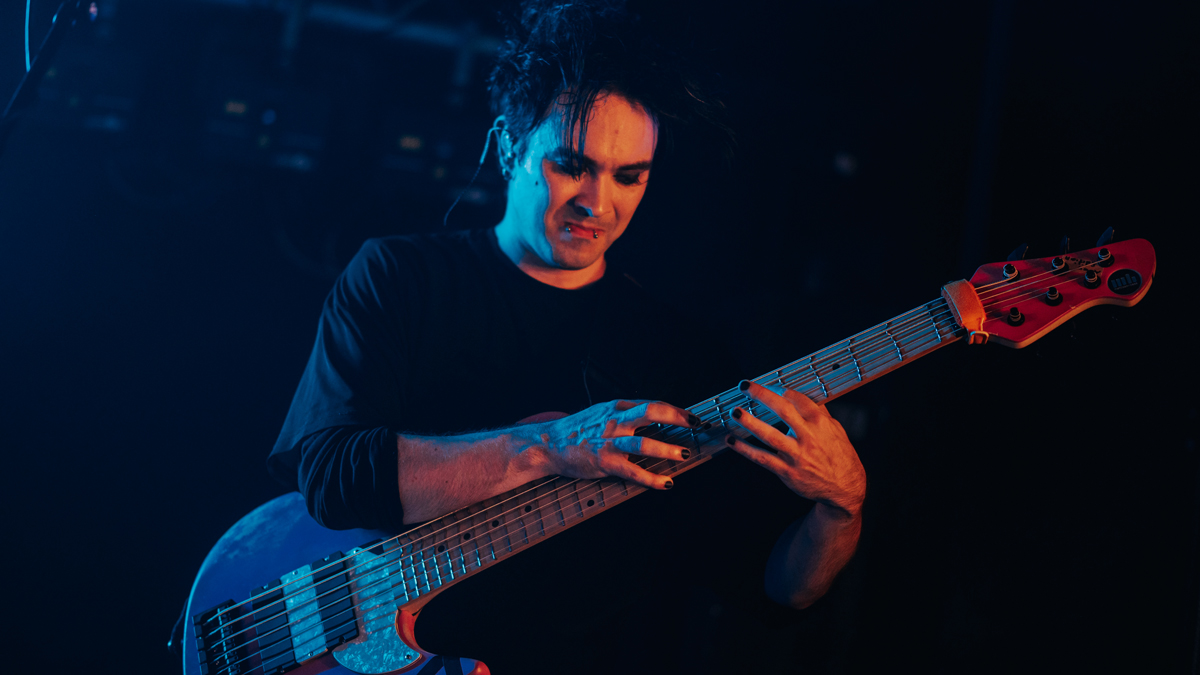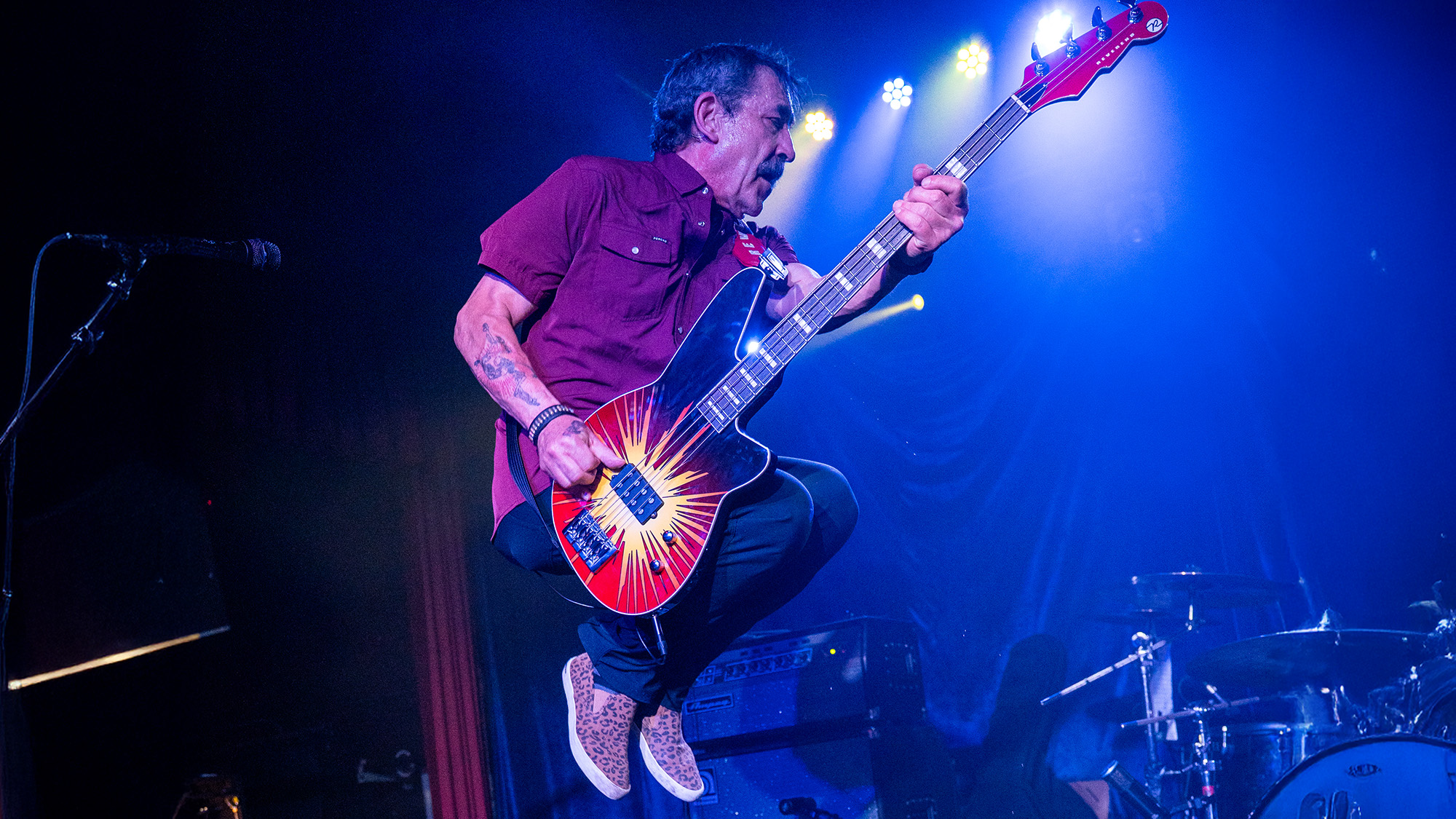Dirty Loops' Henrik Linder: "Set a hysterical end goal that you can’t reach. At least, that works for me!"
One of today's foremost bass virtuosos on how he honed his chops, what makes up his formidable rig, and why his band's bass parts got so weird

Dirty Loops are one of the most important bands of the moment. While their phenomenal musicianship and fusion-based arrangements should make them strictly for musos only, their viral takes on Justin Bieber, Britney Spears and Adele have brought their talents to massive audiences.
As a result, bassist Henrik Linder gets to live the dream, playing technically challenging and musically sophisticated parts while playing to packed audiences around the world.
The Swedish trio’s ability to put devastating chops all over unsuspecting pop tunes will impress even the most hardened gig-goers, and Linder’s slap-happy approach is a major influence on the contemporary bass scene. Their last album, 2021’s Turbo, was a collaboration with Wulfpeck guitarist Cory Wong, yielding a hit with their reinterpretation of Michael Jackson’s Thriller in 6/8 time.
We caught up with Linder as Dirty Loops were making their anxiously awaited UK debut at the Radar Festival. Henrik was thrilled to be playing the UK but humble about his band’s status, picking Australian prog prodigy Plini as his personal festival highlight.
“These kind of gigs are what I want to do the most when making music, so it’s been absolutely amazing,” he grins.
In a wide-ranging interview, Linder talks about his gear, Dirty Loops’ creative process, and how to develop such monstrous technique.
You posted a picture of your Fractal FM9 and pedalboard on Instagram earlier this year. How does your live rig work?
All the latest guitar news, interviews, lessons, reviews, deals and more, direct to your inbox!
“The signal goes into a Morning Star switching system. That is controlled by MIDI by the FM9 to turn on and turn off loops. In the first loop, it’s a Darkglass Hyper Luminal compressor. The second is the Three Leaf Audio Octabvre, a great switchable octaver.
“The third loop is a Boss SY-200 for some synth sounds, and fourth is a Three Leaf Proton envelope filter. The fifth loop has a Fjord Fuzz Fenris and a Darkglass Vintage Microtubes overdrive, so it’s just two different flavors, one fuzz and one distortion. I don’t run them simultaneously that often. I use the fuzz the most. Then it goes into the FM9 and then there’s a stereo out from that. Previously I used a wet-dry-wet rig but this is smoother.
“The FM9 probably has 85% of the sounds. It has all the EQ. I use the compressors in there as well, and all the delays and modulations, harmonizers and weird effects. I also use the FM9’s Plex Delay and Plex Verb. Basically any modulation, delay and reverb, EQ, and pitch shifter stuff is from the FM9.”
A post shared by Henrik Linder (@henriklinder)
A photo posted by on
That’s really clever using the FM9 to control the pedalboard, too.
“That’s the neat thing working with backtracks as well, since you can have a MIDI signal come out of the backing track so it changes all the sounds automatically for me. The backtracks actually turn on the analog pedals from the FM9.
“I just use it for effects. On the lead solo in Follow the Light I use an SY-200 lead sound that’s one octave up. That goes into an amp simulator with a Whammy, some delay and a gate. That’s the only amp simulator I use. It’s just some high-gain amplifier but I don’t really know how to wire those. I just worked until it was 'sounds decent, let’s go with this!'”
Is your recording rig similar?
The sound of Dirty Loops is a little bit of everything all at once
“No, for recording I usually don’t use delays or anything like that from a box. I would use computer effects. I go through an EBS Reidmar, which is one of the cheapest amplifiers, just because I like the way it colors the sound. It’s that into the Universal Audio sound interface, so it’s really DI. If I add some effects before [the amp] I will just have one pedal that goes straight in there.”
Are you working on new Dirty Loops material?
“We recorded about half an album. We still have more songs to write for it, but it will probably be out next year sometime. You will hear that it’s Dirty Loops but it’s definitely also stuff that we haven’t done before. There will be some stuff that’s more orchestral. It’s a little bit all over the place.
“I mean, that’s kind of the sound of Dirty Loops: a little bit of everything all at once, so in that way it’s similar but it’s not done the same way as before. Every song has kind of a different way; it’s not a set formula.”
Is jamming or improvising part of your writing process?
“No, not at all. It’s usually very arranged. A song is usually very simple from the beginning. When the song is done then we arrange it, and then we record it. I guess there’s some improvising when Aron [Mellergård] records his drums, and then I kind of write stuff from what he does or from what Jonah [Nilsson] does.
“I have the luxury of usually recording last so they will sit with me and be like, 'You could try doing this' or 'Try a fill over this drum fill.' The way we to arrange things, it’s not like a jazz setting where we go into a room, do three takes and pick the best one. It takes more time and there’s a lot more cheating going on!”
So are the drums recorded to a demo version?
“Yeah, something that’s finished enough so that there’s the direction of the song. If there’s hits, they are there, but there’s usually just synth bass. I haven’t recorded anything at all when he tracks the drums. He does some takes and experiments a little bit, and then we turn it into a track.”
It was funny when you posted your new Mattisson bass on Instagram and didn’t know the specs.
I have small hands and the wide neck on a P-Bass feels uncomfortable for me
“Yeah, I never really know what’s in the basses! I just tell Anders Mattisson how I want it to sound and how I want it to feel. I think that’s a great way of working with him because he gets what I want and adds his own flavor. When I get the bass there’s always some extra feature that he just put in there.
“My first signature was the traditional Fender kind of thing but with both the Jazz pickups and the P pickup. It’s usually maple neck on all the things. I record slap bass on that bass. The six-string, that’s the pink one, will have a factory-made version.
“The six-string I wanted to have a hybrid that sounded pretty good for slapping and that was also comfortable to play fingers and chords, basically to do the things in Dirty Loops where you had to cover a lot of different aspects. I wanted it to be very even over the fretboard and not have a bass where B string is boomy and that it gets softer when you go higher.
“I play it in single coil 95 percent of the time, but I can pull the volume knobs and then the pickups turn into humbuckers. The other one was all about the slap tone for recording. I wanted to have something that sounded like a traditional active jazz bass, and then he added some other features.
“The P-Bass pickup sounds really good on it, so I could do the P-Bass thing on it as well. I wanted a neck similar to a Jazz bass because I have small hands and the wide neck on a P-Bass feels uncomfortable for me.”
A post shared by Henrik Linder (@henriklinder)
A photo posted by on
Your new basses have Tru Temperament frets – curly-looking frets that offer better intonation. How are you getting on with them?
“It honestly feels exactly like normal frets. That was one of the big keys to changing to them. I think chords are better in tune with them. I think it’s a really great invention for guitar and bass instruments.
“You can only tune it on F’s and A’s if you don’t have a special custom tuner that has the temperament thing because only those notes are in 440. So you have to kind of custom tune it a little bit so but other than that it’s really good.”
What advice would you have for bass players who want to develop a technique as impressive as yours?
It’s really important to be aware of your weak sides. My weak sides in the beginning were definitely timing issues, and my ears had never been really great
“My general advice would be to set a hysterical end goal that you can’t reach. At least, that works for me! You have to see whatever you want to do, and then you shouldn’t care exactly how someone else did it.
“You’ve got to be aware of what works for you. Some players that are great transcribed a lot of solos and some didn’t transcribe at all because it didn’t work for them. If we’re learning a technique, I would sit for the amount of time that you’re focused, and just learn it very thoroughly. Narrow it down to the most basic pattern and learn that.
“It’s really important to be aware of your weak sides. My weak sides in the beginning were definitely timing issues, and my ears had never been really great. I had to learn theory in order to be able to hear it afterwards. I think my talent was that I was good at identifying those things [to practice]. Right now, I struggle with polyrhythms, so I try to focus on learning that. When you focus on learning your weak points, your entire playing accelerates.”

How did you improve your time?
“Some songs that have this quarter-note feel where it’s like [sings an insistent quarter-note pattern a bit like the opening of Dolly Parton’s Nine To Five]. You can’t subdivide that thing.
“The first thing I think people should learn is to play songs that have the quarter-note feel and to be able to feel that in different tempos, because when you do that then you could always relate the eighth note or the triplet to that quarter-note feel. When you’re playing behind the beat, it’s usually the 16th notes that are behind the beat. The quarter notes are usually still on time. Break it down to the most fundamental thing and go into practicing quarter notes then move on.”
You’re lucky to be in a band where you can do pretty much whatever you want.
The other two guys are very involved in writing the bass parts. I think that’s why the bass parts got so weird!
“Yeah, but it’s very much whatever the other two guys want! They are very involved in writing the bass parts. I think that’s why the bass parts got so weird! A lot of it does come from the drummer, where they want specific things, and then you have to learn something new. It’s a challenge for me sometimes, and I’m really grateful for it. It is a completely different approach from when you’re playing behind an artist.”
Do you do many more ‘normal’ bass gigs?
“I did during the pandemic! I wanted to play, so I did whatever gigs were available. At some point it was an eight-people limit in Stockholm for gigs, so we did gigs for eight people and basically made no money at all. I realized that I chose the right profession, because I still wanted to do it when I didn’t get paid for it. I really feel that there’s a challenge in doing things where you play very little and try to do that as good as possible. It’s a different kind of mindset.”
- Tickets for next year's Radar Festival are available from radarfestival.co.uk
Jenna writes for Total Guitar and Guitar World, and is the former classic rock columnist for Guitar Techniques. She studied with Guthrie Govan at BIMM, and has taught guitar for 15 years. She's toured in 10 countries and played on a Top 10 album (in Sweden).



